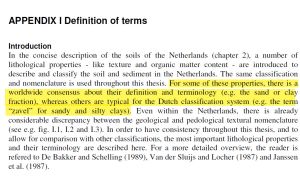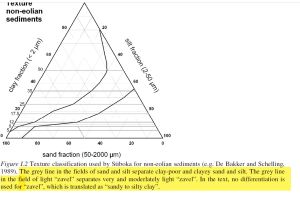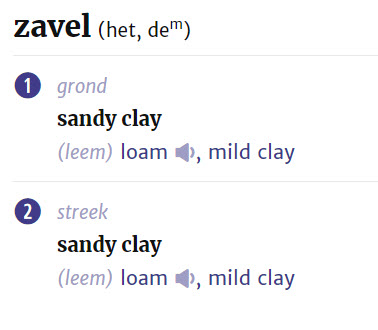No edit summary |
No edit summary |
||
| Line 8: | Line 8: | ||
=== English === | === English === | ||
* | * loam (Onroerend Goed Lexicon) | ||
* sandy clay (Van Dale, Jansonius<ref>Jansonius, H. -- (Nieuw) Groot Nederlands-Engels woordenboek voor studie en practijk</ref>, Wolters<ref>[[WoltersHandwoordenboekNederland-Engels|Wolters’ Handwoordenboek Nederland-Engels (20e druk, 1994)]]</ref>) | * sandy clay (Van Dale, Jansonius<ref>Jansonius, H. -- (Nieuw) Groot Nederlands-Engels woordenboek voor studie en practijk</ref>, Wolters<ref>[[WoltersHandwoordenboekNederland-Engels|Wolters’ Handwoordenboek Nederland-Engels (20e druk, 1994)]]</ref>) | ||
* sand ( | * soil consisting mostly of sand with significant to high levels of clay (Wiktionary) | ||
* coarse sand ([[Comprehensive Dictionary of Industry and Technology (Graham P. Oxtoby)|GWIT]])'''(incorrect)''' | |||
* (chiefly Southern) sand (Wiktionary) | * (chiefly Southern) sand (Wiktionary) | ||
IATE: | IATE: | ||
Revision as of 16:04, 1 December 2023



Dutch
- zavel
English
- loam (Onroerend Goed Lexicon)
- sandy clay (Van Dale, Jansonius[1], Wolters[2])
- soil consisting mostly of sand with significant to high levels of clay (Wiktionary)
- coarse sand (GWIT)(incorrect)
- (chiefly Southern) sand (Wiktionary)
IATE: lichte zavel (aka: lemig zand, leemzand, lemige zandgrond, siltig zand, kleiig zand) def.: ‘grondsoort die bijna hoofdzakelijk uit zand bestaat, aangevuld met 0-30% silt en een verwaarloosbaar percentage lutum’ = loamy sand, loamy sand soil zware zavel (aka: zandige lichte klei) def.: ‘bodemsoort die voor ongeveer drie vierde uit zand en voor ongeveer een vierde uit lutum bestaat en nauwelijk silt bevat’ = sandy clay loam (https://iate.europa.eu/search/result/1701281353597/1)
Most soils clearly belong to two different universa, and as a consequence there are two classification triangles, one for aeolean and one for the other sediments, with an overlap in the sand corner (Figs. 14 and 15, see also 'Bijlage' Ic).
Approximate translation of the terms:
Nomenclature of the aeolean classes:
• leemarm zand - loam-poor sand
• zwak lemig zand - slightly loamy sand
• sterk lemig zand - very loamy sand
• zeer sterk lemig zand - extremely loamy sand
• zandige leem - sandy loam
• siltige leem - silty loam
• kleiige leem - clayey loam
Nomenclature of the nonaeolean classes:
• kleiarm zand - clay-poor sand
• kleiig zand - clayey sand
• silt - silt
• zeer lichte zavel - very light 'zavel'
• matig lichte zavel - moderately light 'zavel'
• zware zavel - heavy 'zavel'
• lichte klei - light clay
• matig zware klei - moderately heavy clay
• zeer zware klei - very heavy clay
("Systeem van bodemclassificatie voor Nederland: de hogere niveaus", 1966)
"De belangrijkste grondsoorten in Nederland zijn zand (48%), zavel (licht en zwaar, 22%), klei (licht en zwaar, 17%) en veen (9%) […] De voor landbouw meest geschikte gronden zijn goed ontwaterde lichte en zware zavelgronden. Deze leveren de hoogste opbrengsten en hebben de minste beperkingen. Daarna volgen de lichte kleigronden; ze zijn minder goed bewerkbaar dan de zavels door het hogere lutumgehalte (‘zwaarder’), en veelal is de draagkracht iets beperkter." ‘Grondsoort en grondprijs’ (https://iate.europa.eu/search/result/1701281353597/1)
Onroerend Goed Lexicon (Aart van den End): • zavel = loam • lichte zavel = light loam • zware zavel = heavy loam • zavelgrond = loamy soil • lichte zavelgrond = light loamy soil
Oxforddictionaries.com: loam: 1. A fertile soil of clay and sand containing humus. 1.1 Geology A soil with roughly equal proportions of sand, silt, and clay. 1.2 A paste of clay and water with sand, chopped straw, etc., used in making bricks and plastering walls.
Van Dale
References
- ↑ Jansonius, H. -- (Nieuw) Groot Nederlands-Engels woordenboek voor studie en practijk
- ↑ Wolters’ Handwoordenboek Nederland-Engels (20e druk, 1994)
- https://en.wiktionary.org/wiki/zavel
- https://dspace.library.uu.nl/bitstream/1874/13275/24/app1.pdf (the thumbnail images on this page are from this document)
- https://london-brussels.blogspot.com/2009/05/place-du-petit-sablon.html (The name “sablon” refers to the yellowish earth layer that could be seen along the shoulders of the dirt roads. This type of sandy clay was called "zavel" in Dutch and "sablon" in French. In the 14th century a small chapel in the sablon area was transformed into an important pilgrimage site where a miraculous statue of Our Lady was venerated.)
